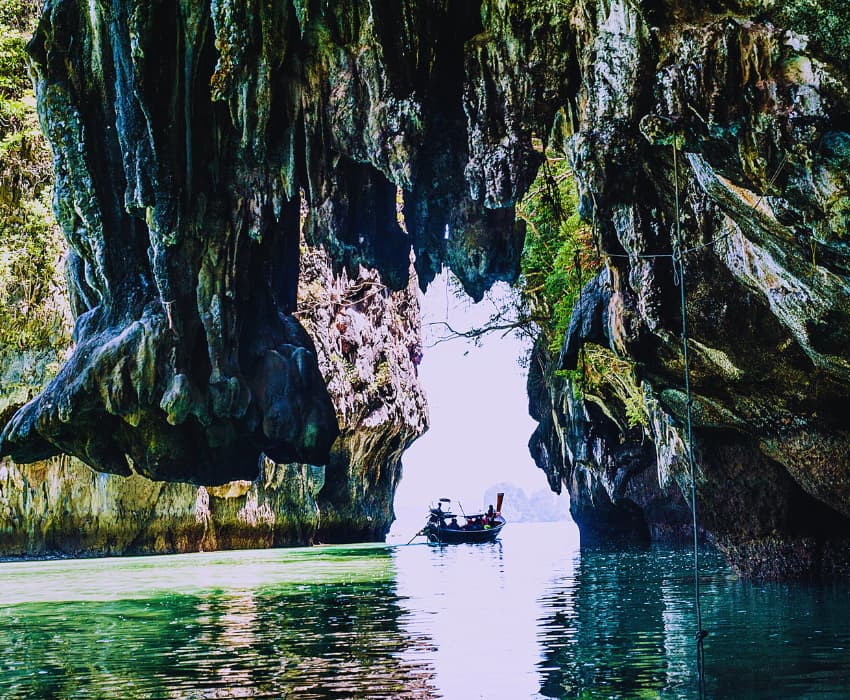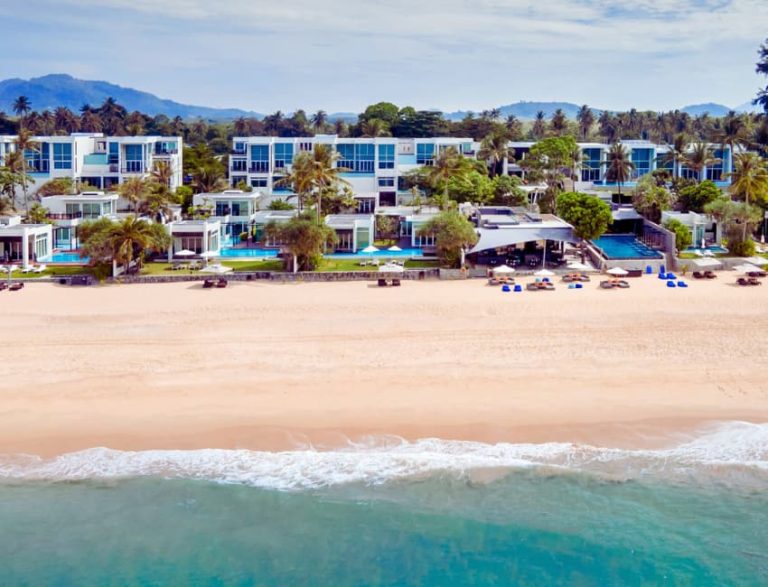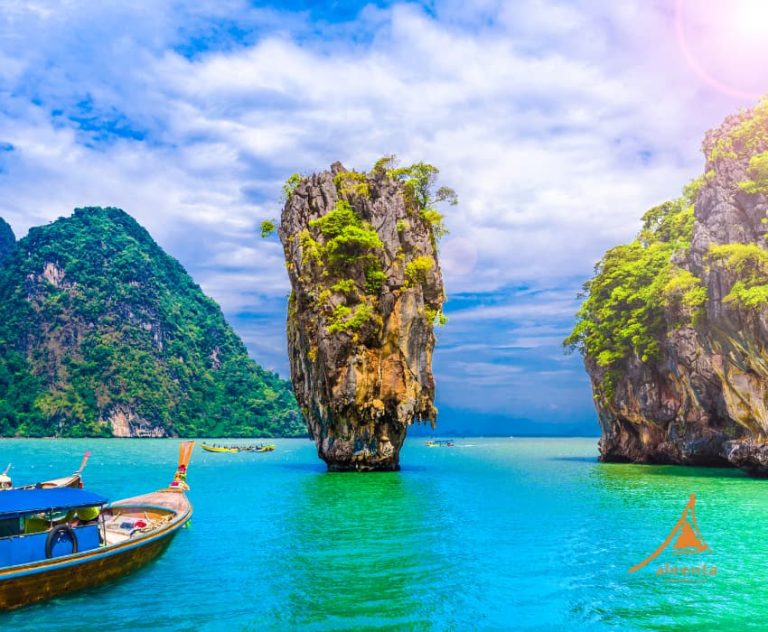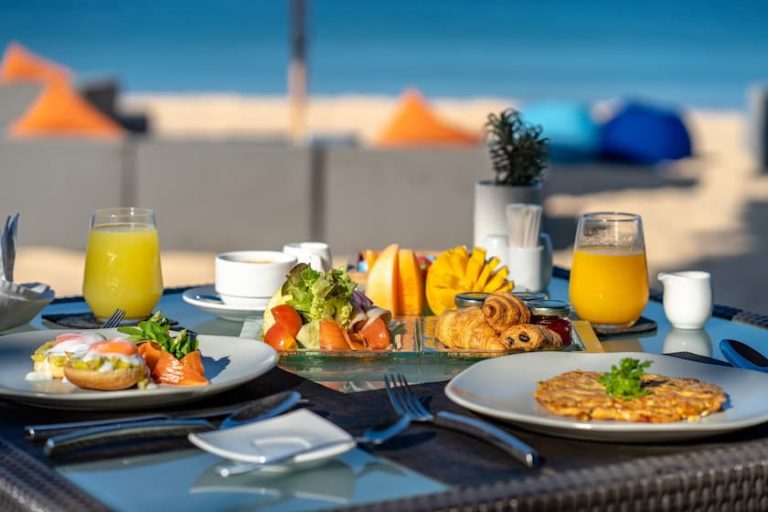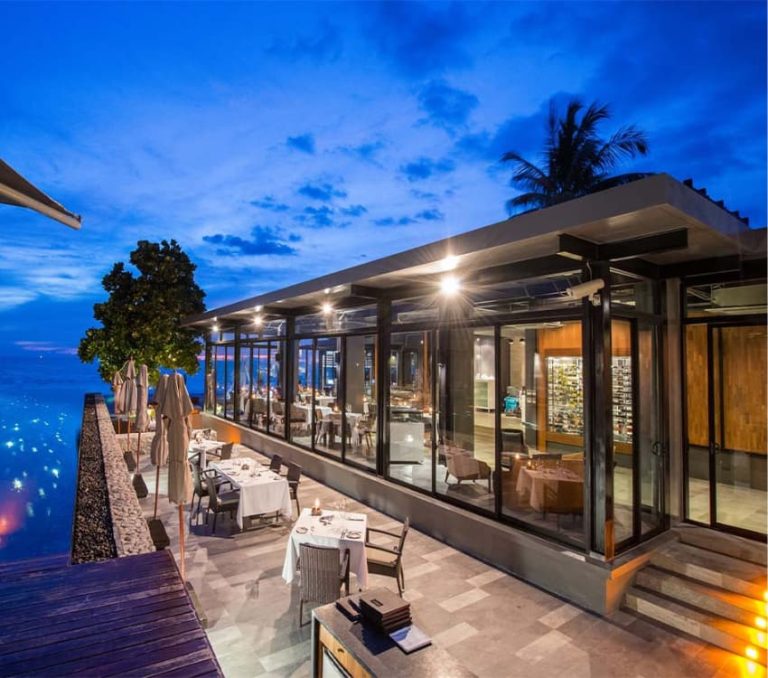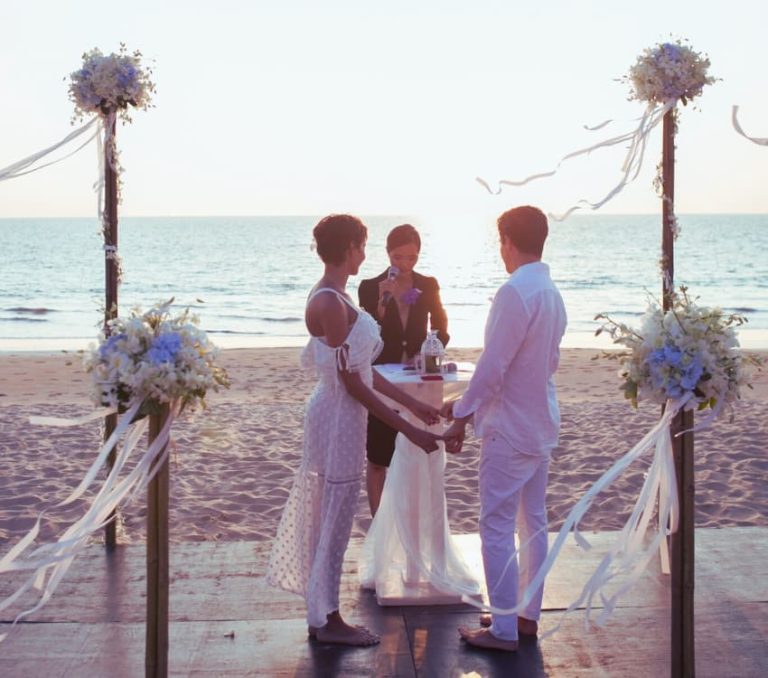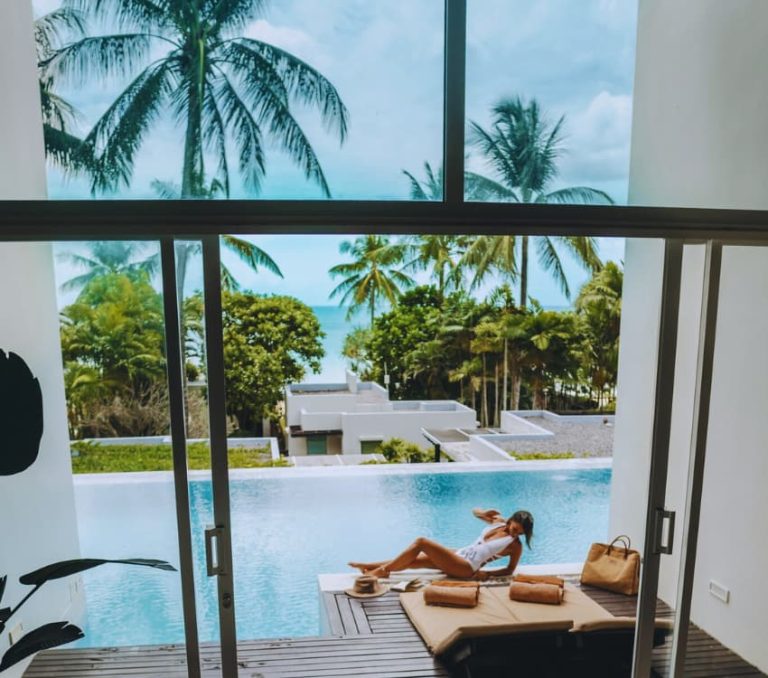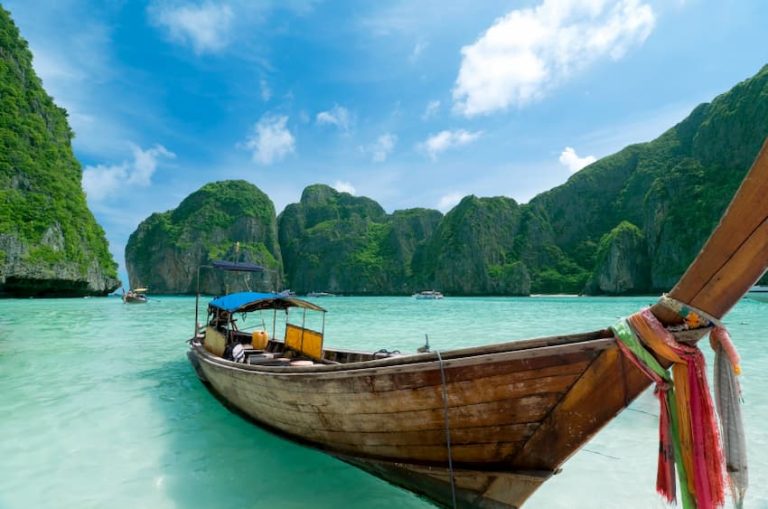Phang Nga Bay, nestled between the island of Phuket and the mainland of southern Thailand, is renowned for its stunning natural beauty and geological significance. This picturesque bay is characterised by its emerald-green waters, dramatic limestone karsts, and lush mangrove forests, creating an awe-inspiring and serene landscape. The bay’s unique topography has made it a prime destination for nature lovers and adventure seekers, drawing visitors from around the globe.
A feature that sets Phang Nga Bay apart is its fascinating network of sea caves. These natural formations, carved over millions of years by the relentless force of the sea, offer a glimpse into the bay’s geological history and present an exciting opportunity for exploration. The sea caves, known locally as “hongs,” are often hidden behind narrow cave entrances and open into secluded lagoons surrounded by towering cliffs. These enchanting caves are a significant attraction, providing a sense of mystery and adventure that captivates all who visit.
For those looking to explore the wonders of Phang Nga Bay, Aleenta Phang Nga Resort & Spa serves as an ideal base. This luxury resort offers exceptional service and easy access to the bay’s many attractions. Guests can enjoy spacious villas with private pools, gourmet dining, and a range of wellness treatments while ideally situated to embark on excursions into the heart of Phang Nga Bay.
The sea caves of Phang Nga Bay are more than just natural curiosities; they are integral to the bay’s appeal and allure. Exploring these caves allows visitors to connect with the natural world, offering a blend of excitement and adventure. Whether kayaking through narrow passages, floating in hidden lagoons, or simply marvelling at the intricate formations, the sea caves provide an unforgettable experience that highlights the extraordinary beauty and significance of Phang Nga Bay.
The Sea Caves of Phang Nga Bay
The sea caves of Phang Nga Bay are remarkable natural formations that have developed over millions of years. These caves are primarily the result of the relentless erosion process, which has shaped the stunning limestone cliffs that characterise the bay. Understanding the formation of these caves provides a deeper appreciation of their beauty and significance.
The creation of sea caves begins with the limestone cliffs that dominate the landscape of Phang Nga Bay. Limestone is a sedimentary rock that is particularly susceptible to erosion by water. Over millions of years, the acidic nature of seawater slowly dissolves the limestone, creating cavities and tunnels within the rock. This process, known as chemical weathering, is accelerated by the movement of the tides and waves, which continually batter the base of the cliffs.
As the tides rise and fall, seawater is forced into the cracks and crevices of the limestone, gradually enlarging these openings. Over time, these small fissures expand into larger cavities, eventually forming the sea caves we see today. The constant ebb and flow of the tides play a crucial role in this process, as the mechanical action of the water further erodes the rock, smoothing out the interiors of the caves and creating intricate formations of stalactites and stalagmites.
Phang Nga Bay’s sea caves are unique in several ways. First, the bay’s relatively shallow waters and the protected environment provided by the surrounding islands allow for preserving these delicate structures. Additionally, the bay’s limestone cliffs are rich in calcium carbonate, contributing to spectacular rock formations within the caves. Combined with the bay’s crystal-clear waters, these formations create a mesmerising, serene, and awe-inspiring environment.
Another distinctive feature of Phang Nga Bay’s sea caves is the presence of hidden lagoons, or “hongs.” These lagoons are often accessible only through narrow cave entrances that can be navigated by kayak or small boat. Once inside, visitors are greeted by tranquil pools of water surrounded by towering limestone walls, creating a secluded and peaceful atmosphere that feels worlds apart from the bustling outside world.
Popular Sea Caves in Phang Nga Bay
-
Tham Lod (Bat Cave)
Tham Lod, commonly known as Bat Cave, is located on Panak Island and is one of the most fascinating sea caves in Phang Nga Bay. This cave gets its name from the large population of bats within its chambers. Visitors can paddle through the cave’s extensive passageways with impressive stalactites and stalagmites. The eerie ambience created by the bats and the natural beauty of the cave’s formations makes Tham Lod a must-see attraction for adventurers and nature enthusiasts.
-
Diamond Cave
Also situated on Panak Island, Diamond Cave is renowned for its dazzling stalactites that reflect light like diamonds, hence its name. The cave’s interior glistens as sunlight filters through, creating a magical and otherworldly atmosphere. Exploring Diamond Cave provides a unique visual experience, as the sparkling formations create a stunning contrast with the cave’s darker recesses. It’s a spectacular sight that highlights the intricate beauty of natural geological processes.
-
Lot Cave (Tham Lod)
Lot Cave, another gem on Panak Island, is celebrated for its long, tunnel-like passage that can be navigated by kayak or small boat. This cave offers adventure as visitors paddle through its narrow entrance into the expansive interior. The journey through Lot Cave is marked by a series of chambers filled with impressive rock formations and the sound of water echoing off the limestone walls. It’s an immersive experience that showcases the dynamic nature of Phang Nga Bay’s sea caves.
-
Blue’s Cave
Located on Hong Island, Blue’s Cave is known for its stunning access to hidden lagoons. Paddling through the cave’s entrance reveals serene, turquoise waters surrounded by high limestone cliffs, creating a secluded paradise. The peaceful environment and the vibrant blue hues of the lagoon make Blue’s Cave a favourite spot for kayakers and photographers seeking to capture the tranquil beauty of Phang Nga Bay.
-
Princess Cave
Princess Cave, situated at Phra Nang Beach in Krabi, is famous for its fertility shrine, filled with offerings and phallic symbols left by local fishermen and visitors. The cave is set against a dramatic limestone backdrop, making it a visually striking location. The shrine’s unique cultural significance and the cave’s natural beauty combine to create an intriguing site that attracts tourists and locals. It’s a place where natural wonder and human tradition intersect, offering a deeper understanding of the region’s cultural landscape.
-
Ice Cream Cave
Back on Panak Island, Ice Cream Cave is named for its rock formations resembling ice cream scoops. This small but charming cave is a delightful stop for visitors exploring the island’s many natural attractions. The whimsical formations and the cool, refreshing air inside the cave provide a pleasant respite from the tropical heat. Ice Cream Cave’s unique shapes and cool interior make it a memorable highlight on any Phang Nga Bay sea cave tour.
Exploring the Sea Caves
-
Kayaking Adventures
Exploring the sea caves of Phang Nga Bay by kayak offers an intimate and immersive experience. Kayaking allows visitors to navigate the narrow entrances of the caves and access hidden lagoons that larger boats cannot reach. The quiet and low-impact nature of kayaking ensures minimal disturbance to the natural environment, making it an eco-friendly choice.
Several recommended routes and tours are available for kayaking enthusiasts. Popular routes often include stops at Tham Lod (Bat Cave), where kayakers can paddle through its extensive passageways, and Blue’s Cave on Hong Island, known for its lagoons. Guided kayaking tours are highly recommended, as local guides can provide valuable insights into the geological formations and ensure a safe and enjoyable experience.
Safety is paramount when kayaking through sea caves. It is essential to wear a life jacket at all times and follow the guide’s instructions. Be mindful of the tides, as water levels can change rapidly, affecting accessibility to certain caves. Bringing waterproof bags to protect your belongings and a flashlight for darker cave interiors can enhance your adventure.
-
Boat Tours
For those who prefer a more relaxed exploration, boat tours offer a comprehensive way to experience the sea caves of Phang Nga Bay. Various boat tours are available, ranging from traditional longtail boats to modern speedboats and luxurious yachts. Each type of tour provides a different perspective of the bay’s stunning landscapes and geological features.
Guided boat tours offer numerous benefits. Experienced guides share detailed information about the history and formation of the caves, as well as the flora and fauna of the area. These tours often include multiple stops, allowing visitors to explore several caves and other attractions within Phang Nga Bay. The convenience of boat tours, combined with the expertise of local guides, ensures a rich and informative experience.
Tour operators in the region provide a range of packages tailored to different interests and budgets. For instance, John Gray’s Sea Canoe offers eco-friendly kayaking and boat tours, emphasising environmental conservation and cultural awareness. Andaman Sea Kayak specialises in small-group tours, providing personalised attention and unique routes highlighting lesser-known caves. Simba Sea Trips offers luxury boat tours with gourmet meals and premium amenities, which are ideal for those seeking a more upscale experience.
Environmental Impact and Conservation
With its stunning sea caves and rich biodiversity, Phang Nga Bay faces significant environmental challenges due to the growing influx of tourists. One of the primary concerns is waste management. The increase in visitors leads to more waste, which can be challenging to manage effectively, especially in such a delicate ecosystem. Improper trash disposal can result in pollution, harming both marine life and the area’s pristine beauty.
Another major issue is pollution from boats and other watercraft. Oil spills, fuel leaks, and boat litter contribute to water contamination, affecting the health of marine species and the overall ecosystem. Additionally, the physical presence of tourists and boats can disturb marine life, disrupting their natural behaviours and habitats.
The effects of tourism on marine life and cave ecosystems are profound. Increased human activity can destroy coral reefs, which are vital to the marine ecosystem. The delicate formations inside the sea caves are also at risk of damage from careless visitors who might touch or break the stalactites and stalagmites. These impacts underscore the need for effective conservation measures to protect Phang Nga Bay’s natural treasures.
-
Conservation Efforts
In response to these challenges, local communities and tour operators have initiated several conservation efforts to protect Phang Nga Bay. Community-led initiatives focus on regular clean-up drives to collect and properly dispose of waste. Education programs are also in place to raise awareness among residents and tourists about preserving the environment.
Tour operators play a crucial role in promoting sustainable tourism practices. Many operators now offer eco-friendly tours that minimise environmental impact. They use non-motorized boats like kayaks to reduce water pollution and avoid disturbing marine life. Additionally, they provide guests with guidelines on how to behave responsibly in natural areas, such as not touching the cave formations and taking all trash back to the mainland for proper disposal.
Sustainable tourism practices are essential for the long-term preservation of Phang Nga Bay. These practices include limiting the number of visitors to sensitive areas, promoting reusable water bottles and bags, and supporting businesses that prioritise environmental sustainability. By adopting these practices, tour operators help ensure that tourism does not come at the expense of the bay’s ecological health.
-
Leave No Trace
Tourists can contribute to conservation efforts by following a few simple guidelines. Firstly, reducing plastic use is crucial. Bringing reusable water bottles, bags, and containers can significantly reduce plastic waste. Tourists should also avoid using single-use plastics, which often pollute the environment.
Respecting local wildlife and natural habitats is another responsibility. Tourists should avoid touching or disturbing marine life and collecting shells or other natural items. When snorkelling or diving, it’s important not to step on coral reefs or stir up sediment, as these actions can damage delicate ecosystems.
Supporting eco-friendly tour operators and accommodations is another way tourists can help. Choosing services that prioritise sustainability encourages the entire industry to adopt greener practices. Finally, tourists should always follow the Leave No Trace principle, ensuring they take all their trash and leave natural areas as they find them.
Tips for Visitors
When planning a trip to explore the sea caves of Phang Nga Bay, packing the right essentials can make your adventure more enjoyable and comfortable. Lightweight, breathable clothing is ideal for the tropical climate. A wide-brimmed hat and sunglasses are essential to protect against the intense sun. High SPF sunscreen will help prevent sunburn during your outdoor activities.
Having the appropriate gear for cave exploration and water activities is essential. Water shoes or sandals with good grip will help you navigate the slippery cave floors. A waterproof bag is crucial for keeping your belongings dry, especially kayaking. Bringing a reusable water bottle will keep you hydrated without contributing to plastic waste. Additionally, a flashlight or headlamp can be handy for illuminating darker cave interiors.
-
Best Times to Visit
The best time to visit Phang Nga Bay is during the dry season, from November to April. The weather is typically sunny and pleasant during these months, with lower humidity and minimal rainfall. This period offers the most comfortable conditions for exploring the caves and enjoying water activities.
Weather considerations are essential, as the wet season, from May to October, brings higher humidity and frequent rain showers. These conditions can make exploring the caves more challenging and less enjoyable. Checking the weather forecast before your trip can help you plan accordingly.
Tidal schedules are also crucial when visiting the sea caves. Some caves are only accessible at certain times of the day, depending on the tide. Low tide often reveals the cave entrances and allows easier access, while high tide may make them impassable. Consulting with local tour operators about the best times to visit specific caves based on the tides will ensure you have the best experience.
-
Safety Considerations
Safety is paramount when exploring the sea caves of Phang Nga Bay. Always follow your guide’s instructions, as they are knowledgeable about the local conditions and potential hazards. Guides can provide valuable information on the safest routes and help navigate the more challenging parts of the caves.
Always wear a life jacket when kayaking or boating, regardless of your swimming ability. The waters around the caves can be unpredictable, and a life jacket provides essential safety in an emergency. Be cautious of your surroundings to avoid injury, especially in areas with low ceilings or narrow passages.
Exploring the caves requires a mindful approach. Avoid touching or disturbing the delicate rock formations, as they are fragile and take thousands of years to form. Respecting the natural environment ensures that these beautiful caves remain pristine for future visitors.
Accommodation and Travel Logistics
Our luxury beach resort in Phang Nga offers a range of amenities and services to provide a relaxing and memorable stay. Guests can enjoy spacious villas with private pools, gourmet dining options, and rejuvenating treatments at the Ayurah Spa & Wellness Centre. The resort’s focus on comfort and elegance ensures a high-quality experience for every visitor.
Aleenta Phuket’s prime location on the serene Natai Beach makes it an ideal base for exploring Phang Nga Bay. The resort is just a short drive from the central piers, providing easy access to boat tours and other excursions into the bay. This proximity allows guests to conveniently embark on adventures to the sea caves and other attractions, maximising their time enjoying the area’s natural beauty.
-
Travel Logistics
Getting to Phang Nga Bay from Phuket or Krabi is straightforward, with several transportation options.
From Phuket, travellers can take a taxi, private car, or shuttle service to one of the many piers, such as Ao Po Grand Marina or Royal Phuket Marina. The drive typically takes about an hour, depending on traffic and the specific location of the departure point. Once at the pier, various boat tours are available to take visitors into Phang Nga Bay and its renowned sea caves.
The journey to Phang Nga Bay from Krabi is equally convenient. Taxis and shuttle services are readily available from Krabi Town or Krabi International Airport, and it takes around 90 minutes to reach the main piers. From there, visitors can join a boat tour to explore the bay.
Phang Nga Bay’s transportation options include longtail boats, speedboats, and kayaks. Longtail boats are a traditional and scenic way to travel, offering a slower pace that allows for more leisurely sightseeing. Speedboats provide a faster alternative, ideal for covering more ground in a shorter time. Kayaking is perfect for those exploring the caves and hidden lagoons up close, offering an intimate and eco-friendly way to experience the bay.
Related Articles
- Exploring Phang Nga Bay
- Islands in Phang Nga Bay
- Koh Panyee Island in Phang Nga Bay
- Visiting Phang Nga Town
- National Parks In Phang Nga Province
Aleenta Phuket
Phang Nga Resort & Spa
Phang Nga Resort & Spa
33 Moo 5, Khok Kloi,
Takua Thung, Phang Nga
82140 Thailand
T: +66 (0) 76 580 333

